Explore Chopta Tungnath Trek – Perfect Himalayan Retreat
Published on January 09, 2025
The Chopta Tungnath Trek is one of the most enchanting treks in Uttarakhand, offering trekkers the perfect combination of spiritual awakening, adventure, and nature's beauty. Located in the Garhwal region, Chopta serves as the base for the trek to the famous Tungnath Temple, which holds immense religious significance as one of the highest Shiva temples in the world. With stunning views, a well-defined trail, and the backdrop of towering Himalayan peaks, this trek is ideal for both seasoned trekkers and those new to the world of trekking. Here’s why the Chopta Tungnath Trek is the perfect Himalayan retreat and why it should be on every trekker’s bucket list.
Chandrashila Trek Highlights: Sunrise, Spirituality, and More
The Chandrashila Trek is more than just an exhilarating adventure; it's a spiritual journey that leads you to one of the most picturesque and sacred peaks in the Himalayas. Known for its stunning sunrise views, tranquil surroundings, and rich cultural heritage, this trek attracts adventure seekers and spiritual enthusiasts alike. If you’re planning to take on the Chopta Chandrashila Trek, here are some of the highlights that make this journey unforgettable.
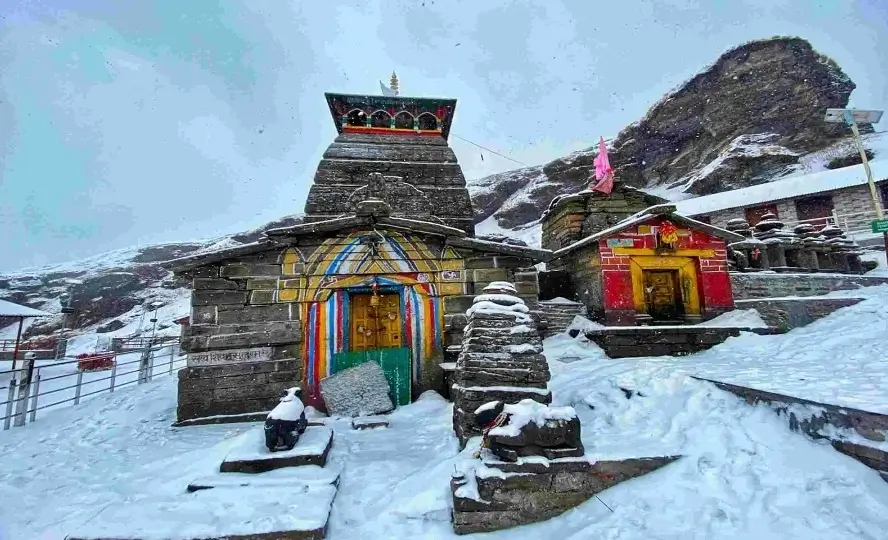
1. The Majestic Sunrise at Chandrashila Summit
One of the most rewarding moments of the Chandrashila Summit Trek is the sunrise. As the first light hits the snow-covered peaks of the Himalayas, the view from the summit is absolutely breathtaking. The sun rises over a majestic landscape of towering mountains, including Nanda Devi, Trishul, and Chaukhamba, making it an experience you’ll never forget. Whether you're on the Tungnath Temple Trek or trekking toward Chandrashila, the early morning hike to the summit is a spiritual and visual delight. The peacefulness of the moment as the world slowly wakes up around you adds a deeper sense of connection to nature and the mountains.
2. Spiritual Significance of Tungnath Temple
As you embark on the Chopta Chandrashila Trek, one of the key highlights is the spiritual experience at the Tungnath Temple, the highest Shiva temple in the world. The temple, situated at an altitude of 3,680 meters, is an important pilgrimage site for devotees, especially during the Char Dham Yatra. As you ascend toward the temple, you can feel the energy shift. The surrounding natural beauty and the reverence of the place offer a deep sense of peace and spiritual solace. The combination of trekking through serene forests, crossing meadows, and reaching a temple dedicated to Lord Shiva makes this trek an essential part of the Chopta Tour Package.
3. The Thrilling Ascent to Chandrashila Summit
The journey toward Chandrashila Summit is both physically demanding and mentally rewarding. Starting from Chopta, the trek takes you through lush forests and grassy meadows, leading up to the higher elevations where the air is thin and the views become even more dramatic. The final push to the summit of Chandrashila is steep but exhilarating. Once at the top, you’ll be treated to a 360-degree view of the majestic peaks of the Himalayas. The entire trek, culminating in this glorious summit, is a once-in-a-lifetime experience.
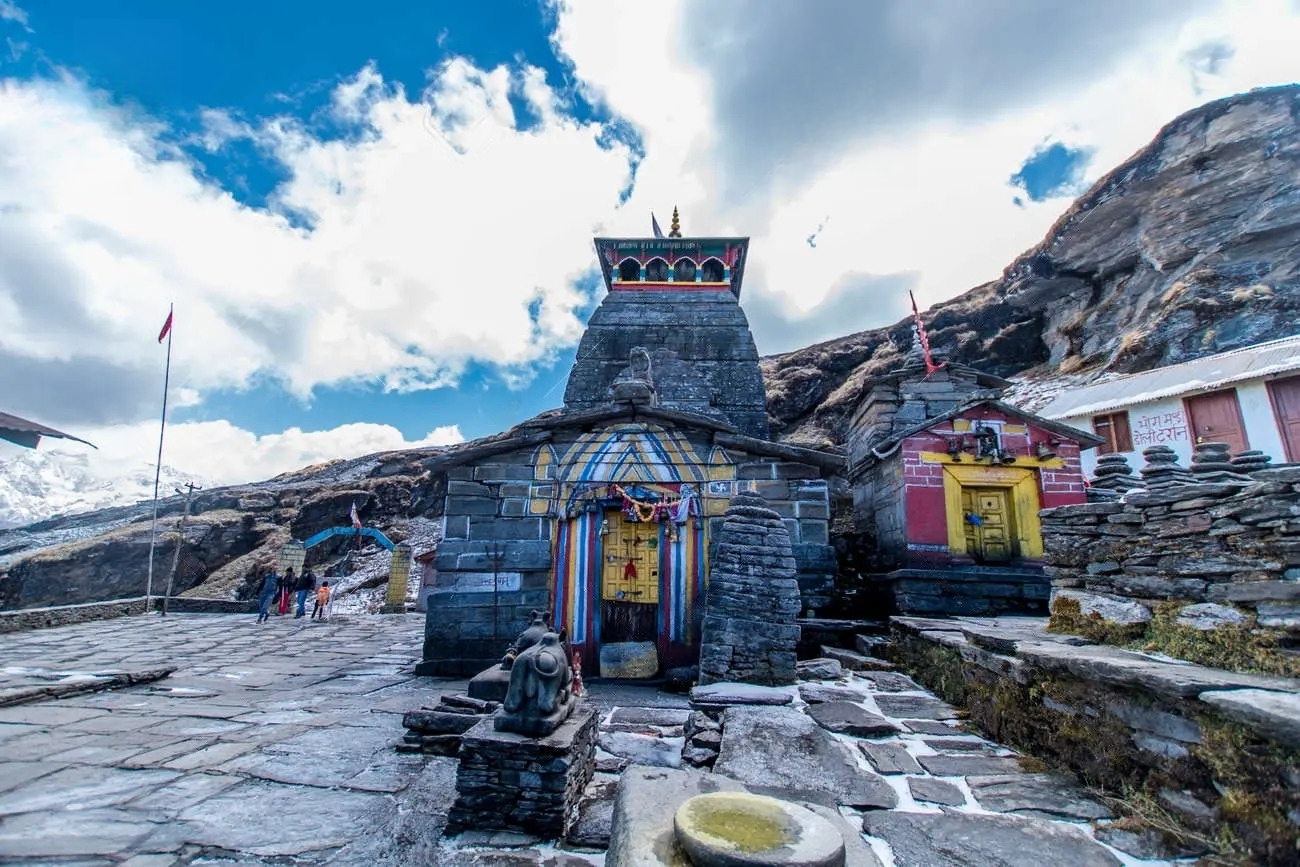
4. Beautiful Campsites and Scenic Views
Camping along the Chopta Chandrashila Trek offers another highlight of the journey. Most trekkers choose to stay overnight in camps along the route, allowing them to take in the tranquil beauty of the surrounding landscape. As you rest under the stars, the night sky in the mountains is awe-inspiring, free from the light pollution of the cities. The peaceful environment is perfect for reflection, photography, or simply unwinding after a day of trekking. The views from the campsites, especially as you wake up to the crisp mountain air, are an experience you won’t find anywhere else.
5. Adventure and Challenge: A Trek for All
While the Chopta Chandrashila Trek from Delhi is a relatively easy trek compared to some of the more difficult Himalayan treks, it still presents enough challenges to keep it exciting for experienced trekkers. The elevation gain, rocky paths, and varying weather conditions provide a good test of your endurance. At the same time, it’s accessible to beginners, making it an ideal trek for people of all skill levels. Whether you're looking for adventure or spirituality, the Chandrashila Trek caters to everyone.
6. Rich Flora and Fauna
Throughout your trek, you’ll be surrounded by the natural beauty of the Chopta region, home to an impressive variety of flora and fauna. As you make your way up to Tungnath and Chandrashila, you’ll pass through thick forests of oak, rhododendron, and deodar trees, which bloom with vibrant colors during the spring season. The area is also a haven for birdwatchers, with species like the Himalayan monal, griffon vulture, and numerous other birds and wildlife. The diverse ecosystem adds an extra layer of beauty to the trek, making each step an adventure in itself.
7. A Journey of Self-Discovery
For many, the Chandrashila Summit Trek is more than just a physical challenge; it’s an opportunity for personal growth and self-discovery. The solitude of the trek, combined with the breathtaking surroundings and the spiritual aura of Tungnath Temple, offers ample moments for introspection. Whether you're contemplating life at the summit or meditating near the temple, the trek encourages you to disconnect from the noise of daily life and reconnect with yourself. This journey is as much about the internal experience as it is about the external adventure.
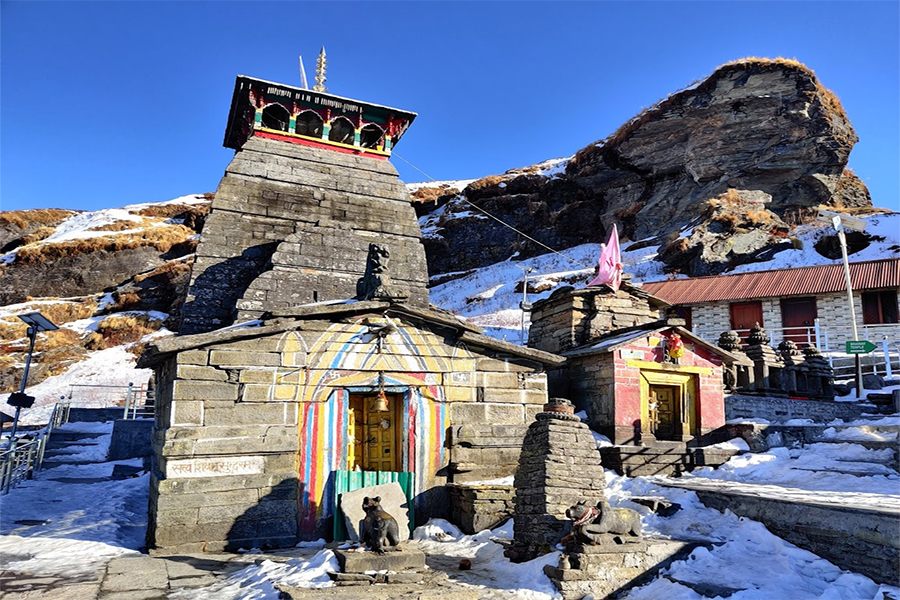
8. A Perfect Getaway with Chopta Tour Packages
For those looking for a well-planned, hassle-free adventure, the Chopta Tour Packages are a great option. These packages typically include everything from transportation (including Chopta Chandrashila Trek from Delhi), meals, accommodation, and the expertise of experienced guides. Whether you’re traveling solo, as a couple, or in a group, opting for a tour package makes the experience smoother, allowing you to focus on enjoying the trek instead of worrying about logistics. The packages also ensure that you’re well-acclimatized to the altitude and prepared for the trek's physical demands.
9. Conquering the Summit
The true reward of the Chopta Chandrashila Trek is reaching the summit. Standing at Chandrashila, you’re not just physically elevated—you’re also elevated spiritually and mentally. The majestic view of the surrounding snow-capped peaks, the valleys below, and the vast sky above is nothing short of mesmerizing. For those who complete the trek, the summit represents a significant achievement, a personal victory over the challenges of altitude, terrain, and weather. It’s a moment of pure exhilaration and pride, where you can stand on top of the world and take in all the beauty around you.
The Scenic Journey to the Chopta Tungnath Trek
Starting from Chopta, the trek to Tungnath Temple is approximately 3.5 kilometers long, making it accessible even for those who aren’t seasoned trekkers. The route takes you through lush green meadows, dense forests of oak, pine, and rhododendron, and offers amazing views of the Himalayan peaks. Throughout the trek, trekkers are rewarded with picturesque views of the surrounding landscape, including the mighty peaks of Nanda Devi, Trishul, and Kedarnath. These towering giants of the Himalayas serve as a constant reminder of the beauty and power of nature.
As you trek further up, the landscape changes with the altitude. The trail gradually ascends, leading to the Tungnath Temple, where the majestic view of the snow-covered peaks and the surrounding valleys unfold before your eyes. The sight from the temple is surreal, with panoramic vistas of the Himalayan range stretching out endlessly. Whether you visit during the warmer months or during the snow-laden winters, the view is nothing short of mesmerizing. The sense of achievement when you reach the temple is unmatched, and the view from the summit adds to the overall appeal of this trek.
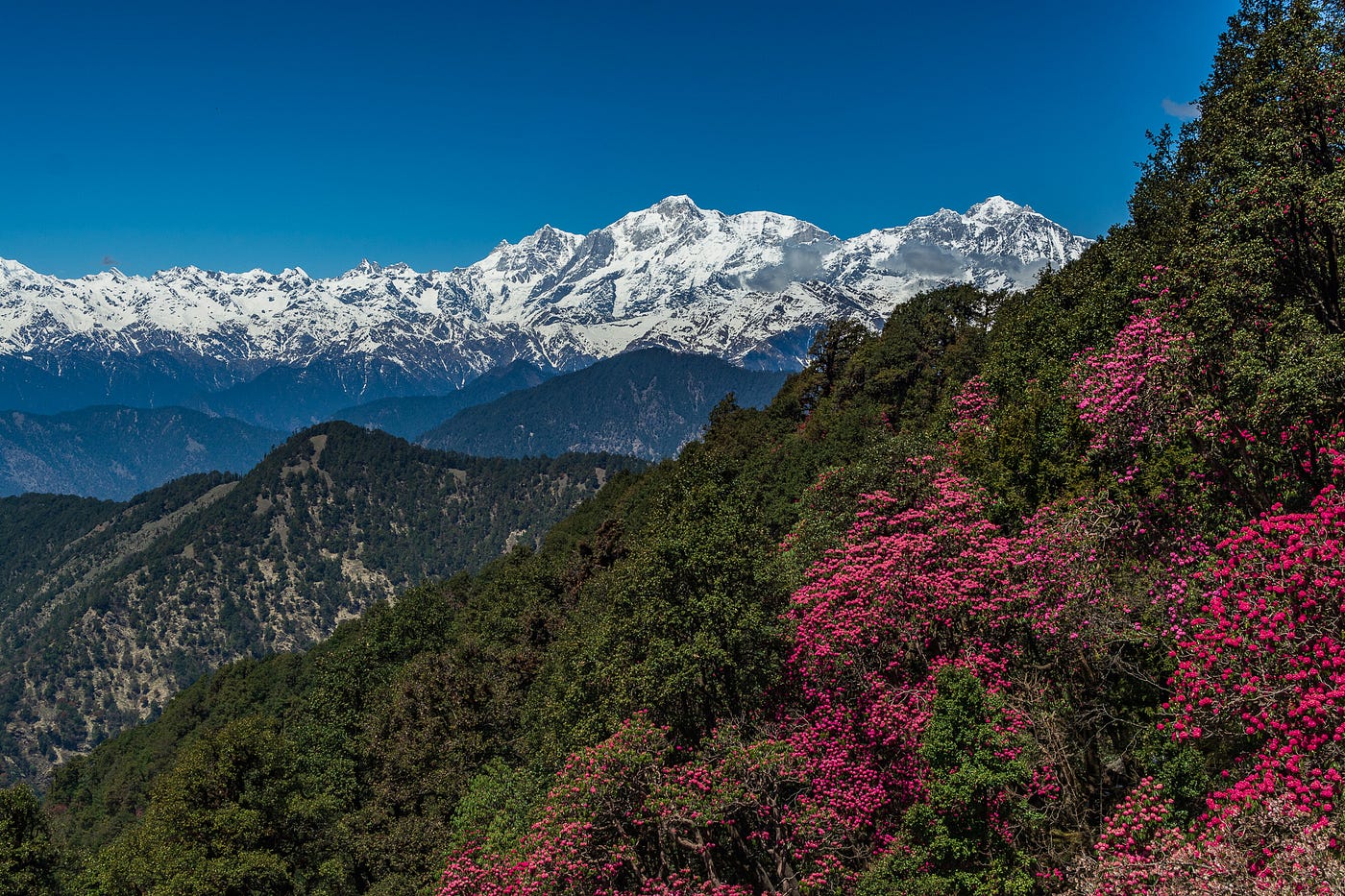
The Beauty of Chopta: A Hidden Gem
Chopta, often considered the base for the Tungnath Chandrashila Trek, is a hidden gem in the Himalayas that still retains its natural charm. Unlike other popular trekking destinations, Chopta is relatively less commercialized, offering a peaceful atmosphere that makes it perfect for trekkers looking to disconnect from the stresses of daily life. The village is situated at an elevation of around 2,680 meters and is surrounded by lush meadows, alpine forests, and high-altitude lakes. The pristine beauty of Chopta makes it a wonderful retreat for nature lovers and adventure seekers alike.
The area is rich in biodiversity, with a variety of bird species, wildflowers, and animals that call this region home. The Chopta region also serves as a base for treks to Chandrashila Summit, a popular summit that offers magnificent 360-degree views of the surrounding Himalayan peaks. Whether you are an adventure enthusiast or someone who enjoys the peace and quiet of nature, Chopta offers something for everyone.
Trekking Tips for the Chopta Tungnath Trek
While the Chopta Tungnath Trek is relatively easy, there are a few tips to keep in mind for a safe and enjoyable journey. First and foremost, ensure you are physically prepared for the trek. Though it’s a short trek, the altitude can make the hike a bit more strenuous, especially for those who are not used to high altitudes. Carry enough water, snacks, and a packed lunch for the journey, as there are limited food options along the trail.
It’s also advisable to carry suitable clothing based on the season. During summer months, light clothing and a light jacket should suffice, but if you are trekking during the winter, make sure to pack warm clothing, gloves, and a hat. Additionally, good trekking shoes with proper ankle support are essential for a smooth journey.
Accommodation Options in Chopta
Accommodation in Chopta varies depending on your budget and preferences. There are several guesthouses, hotels, and homestays available in the region. Many trekkers also choose to stay in campsites, which allow them to fully immerse themselves in the beauty of nature. If you’re booking a Chopta Tour Package, your accommodation will likely be taken care of, ensuring a hassle-free experience. Many packages include meals and provide comfortable stays in both guesthouses and tents.

Sleeping Bag vs. Blanket: What Works Best for Chandrashila?
When preparing for the Chandrashila Trek, one of the key decisions you’ll face is whether to bring a sleeping bag or a blanket for your overnight stays at camps. The Chopta Chandrashila Trek, known for its stunning vistas and spiritual significance, can also be demanding due to the high-altitude conditions. The right sleeping gear plays a vital role in ensuring a comfortable and safe experience. With temperatures dropping significantly during the night, choosing the appropriate insulation is crucial for your trek, especially when you're tackling the chilly nights of the Tungnath Temple Trek or making your way to the Chandrashila summit trek.
The Benefits of a Sleeping Bag for the Chandrashila Trek
A sleeping bag is often the go-to choice for trekkers on high-altitude hikes like the Chopta Chandrashila Trek. Its design and insulation provide optimal warmth, which is particularly important when you're camping under the stars in freezing temperatures. Since the Chopta Tour Package generally includes overnight stays in camps or guesthouses along the route, a sleeping bag is an ideal choice for keeping warm during cold nights.
Sleeping bags are specifically designed to trap heat, keeping your body warm and insulated from the cold ground. The Chopta Chandrashila Trek from Delhi and other regions is known for its cold evenings, and a sleeping bag provides the necessary protection from the cold air, ensuring a restful night before the final push to Chandrashila Summit.
Moreover, sleeping bags are lightweight and compact, making them easier to pack than bulky blankets. Given the physical nature of the Tungnath Temple Trek, where you will need to keep your load light, a sleeping bag becomes an essential piece of gear for trekkers. Many modern sleeping bags are also water-resistant, offering additional protection from any unexpected rain or moisture, a common challenge at higher altitudes like those in the Chopta Chandrashila Trek.
The Advantages of a Blanket for the Trek
While a sleeping bag is often favored for high-altitude treks, a blanket can also be a suitable option for some trekkers, especially those who tend to feel too constricted in a sleeping bag. Blankets offer more freedom of movement, which can be important for those who don’t sleep well in the snug environment of a bag. However, blankets may not be as warm as sleeping bags and require more attention to warmth retention. During the Chopta Chandrashila Trek, where temperatures can dip well below freezing, a blanket may not provide the same level of insulation as a well-designed sleeping bag.
A blanket might work well if you are traveling during the warmer months or if you’re planning on staying in guesthouses or accommodations that already have heated rooms. But for trekkers heading to the Chandrashila summit trek, a blanket might not provide sufficient warmth, especially in the colder winter months when temperatures plummet after dark.
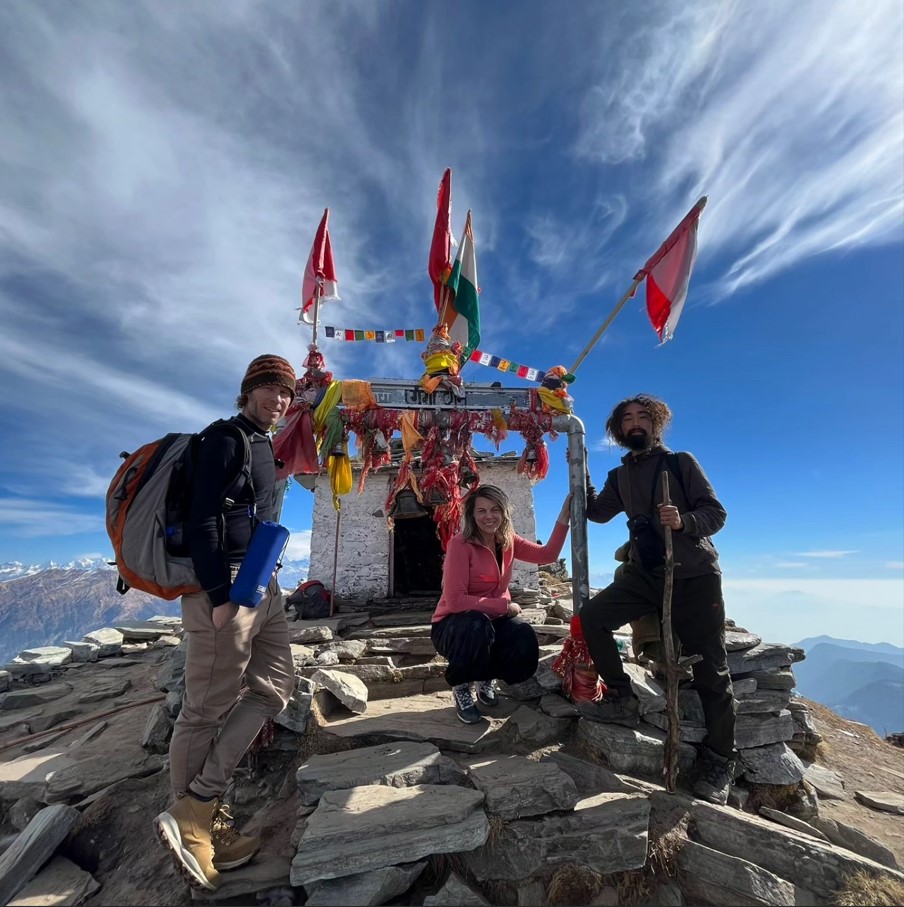
What to Consider for Your Chandrashila Summit Trek
When choosing between a sleeping bag and a blanket for your Chopta Chandrashila Trek, consider several factors. First, think about the time of year you're traveling. During winter, temperatures at Chopta and Tungnath Temple can drop significantly, so a sleeping bag with high insulation is recommended. Even though blankets may be comfortable, they are less practical in extreme cold conditions that you may encounter when trekking up to Chandrashila Summit.
If you're going during the warmer months, especially during spring or autumn, a blanket might be enough for basic warmth. However, if you're trekking in winter, opting for a sleeping bag ensures that you remain warm and protected from the cold, enabling you to rest well before the next day's trek.
Why Altitude Training Helps for the Chandrashila Trek
The Chandrashila Trek is a thrilling adventure that rewards trekkers with unparalleled views of the Himalayas. However, its high altitude poses a challenge for many. The trek reaches an elevation of 4,000 meters, which can lead to altitude sickness if you're not properly acclimatized. This is where altitude training comes into play, preparing trekkers physically and mentally for the demands of the Chandrashila Summit Trek.
Preparing for the Elevation with Altitude Training
When you embark on a trek like the Chopta Chandrashila Trek, the air gets thinner as you climb higher, making it harder to breathe. This can lead to dizziness, shortness of breath, and fatigue, symptoms of altitude sickness. Altitude training helps in adapting your body to higher altitudes, reducing the risks associated with this phenomenon. Through gradual exposure to lower oxygen levels, your body learns to optimize its oxygen use, improving endurance and reducing discomfort during the Chopta Chandrashila Trek.
For trekkers starting their journey from Delhi, altitude training becomes even more essential. While Chopta Tour Packages typically include a well-structured itinerary to help with acclimatization, preparing yourself beforehand through altitude training can enhance the experience. The better prepared you are, the more you'll be able to enjoy the journey rather than struggling with altitude-related issues.
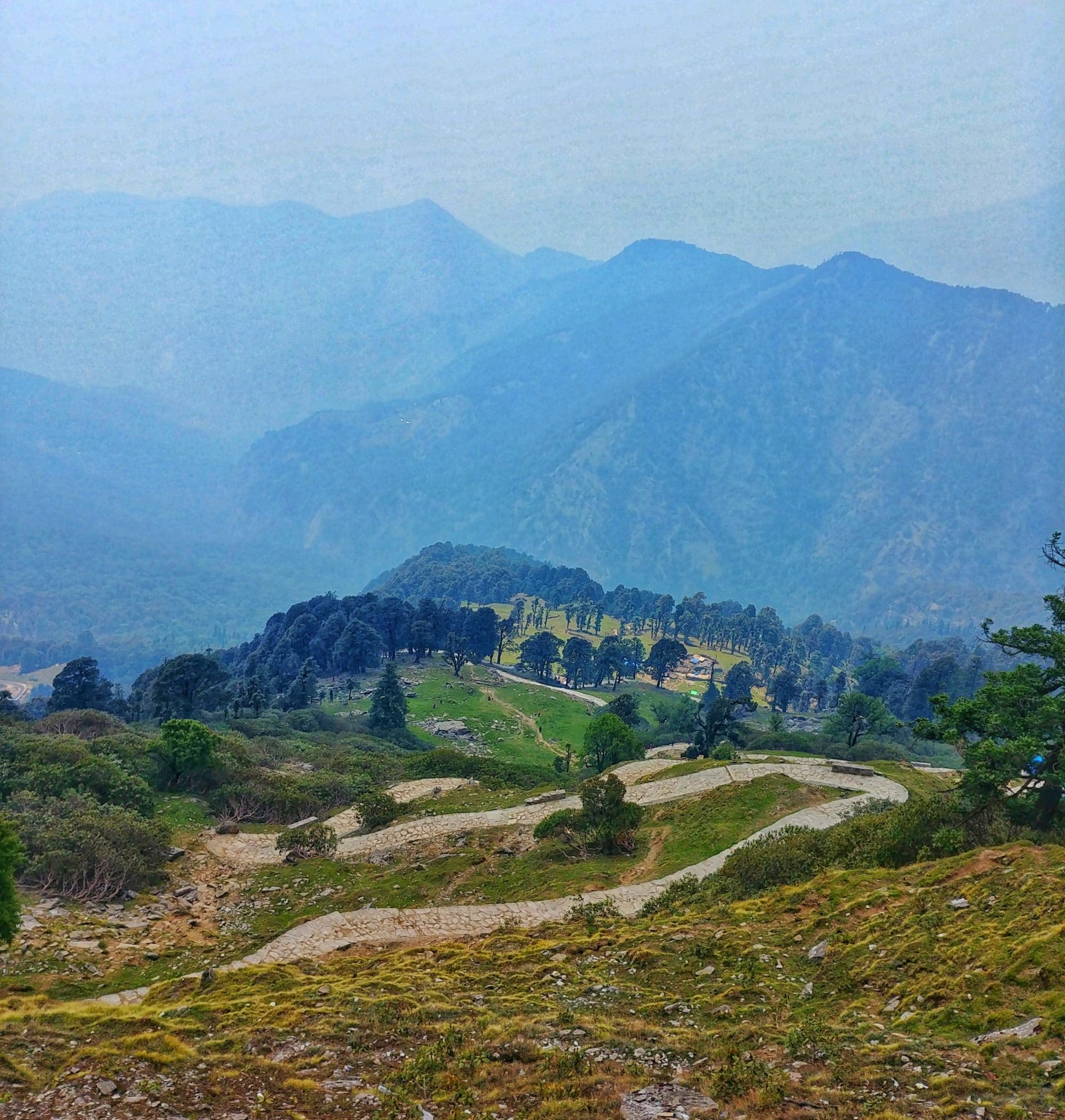
The Benefits of Altitude Training for the Chandrashila Summit Trek
Altitude training not only helps in preventing altitude sickness but also boosts overall performance. By strengthening your cardiovascular system and improving lung capacity, you’ll find the Tungnath Temple Trek leading up to the Chandrashila summit trek easier. The higher you go, the more your body requires efficiency in oxygen utilization. Altitude training increases red blood cell count, which allows for better oxygen delivery to muscles, reducing fatigue and making it easier to tackle the higher elevations of Chopta Chandrashila Trek.
Furthermore, altitude training also enhances your mental toughness. Chopta Chandrashila Trek from Delhi requires both physical and mental stamina. Being mentally prepared for the strain of the trek is crucial for pushing through challenging moments. The improved focus and resilience gained from altitude training ensure that you approach the summit with confidence.
How to Include Altitude Training in Your Preparation
Training for the Chandrashila Summit Trek involves both physical preparation and a specific focus on altitude acclimatization. One key aspect is increasing your cardiovascular endurance. Regularly hiking at moderate altitudes, gradually increasing the intensity, and utilizing hiking trails that simulate high altitudes can be beneficial. For trekkers preparing for the Chopta Chandrashila Trek, try to include hikes or runs at higher altitudes near your location to get used to less oxygen. Additionally, some trekkers use training masks that simulate high-altitude conditions.
While Chopta Tour Packages often include proper acclimatization periods during the trek itself, it's important to prepare in advance. Combining altitude training with general fitness routines will allow you to build the strength necessary for completing the trek comfortably.
The Role of Acclimatization During the Trek
Even if you've done altitude training, acclimatization is key to a successful Chandrashila Trek experience. Acclimatization is the process of allowing your body to gradually adjust to the decreased oxygen levels at higher altitudes. When you reach Chopta, the Tungnath Temple Trek serves as a natural acclimatization point before ascending to the summit. If you're coming from Delhi, which is at a much lower altitude, the gradual increase in elevation during the trek will help your body adjust.
Choosing a Chopta Tour Package that allows for gradual ascents is essential. Packages with a well-planned itinerary help ensure you have enough time to acclimatize at various stages of the trek. The aim is to avoid rushing to the summit and to give your body time to adjust to the altitude to minimize the risk of sickness.

Embarking on a trek, especially in high-altitude regions like the Himalayas, is an exhilarating experience that combines physical challenge with breathtaking natural beauty. However, one of the most critical yet often overlooked aspects of trekking at higher elevations is acclimatization. Proper acclimatization plays a pivotal role in ensuring not only your safety but also the overall enjoyment of your journey. Whether you're planning a trek to iconic destinations like Chopta Chandrashila, Roopkund, or Everest Base Camp, understanding and prioritizing acclimatization can make all the difference between a memorable adventure and a potentially dangerous ordeal.
Understanding Acclimatization: What It Is and Why It Matters
Acclimatization refers to the physiological process by which the human body adjusts to changes in altitude, particularly reduced oxygen levels. As you ascend to higher altitudes, the air becomes thinner, containing less oxygen per breath. This decrease in oxygen availability can lead to a condition known as altitude sickness (or acute mountain sickness), characterized by symptoms such as headaches, nausea, fatigue, dizziness, and shortness of breath. In severe cases, it can progress to life-threatening conditions like High Altitude Pulmonary Edema (HAPE) or High Altitude Cerebral Edema (HACE).
The body needs time to adapt to these lower oxygen levels. During acclimatization, several physiological changes occur, including increased breathing rate, enhanced red blood cell production, and improved oxygen delivery to tissues. These adaptations allow trekkers to function effectively at higher altitudes without succumbing to altitude-related illnesses. Skipping or rushing this process can jeopardize both your health and your trekking experience.
For instance, during popular treks like the Chopta Chandrashila route, which reaches altitudes above 4,000 meters, failing to acclimatize properly could mean missing out on the stunning views from Chandrashila peak due to debilitating symptoms of altitude sickness. By contrast, taking the time to acclimatize ensures that you can fully appreciate the panoramic vistas of snow-capped peaks like Nanda Devi and Trishul while maintaining your energy and well-being.
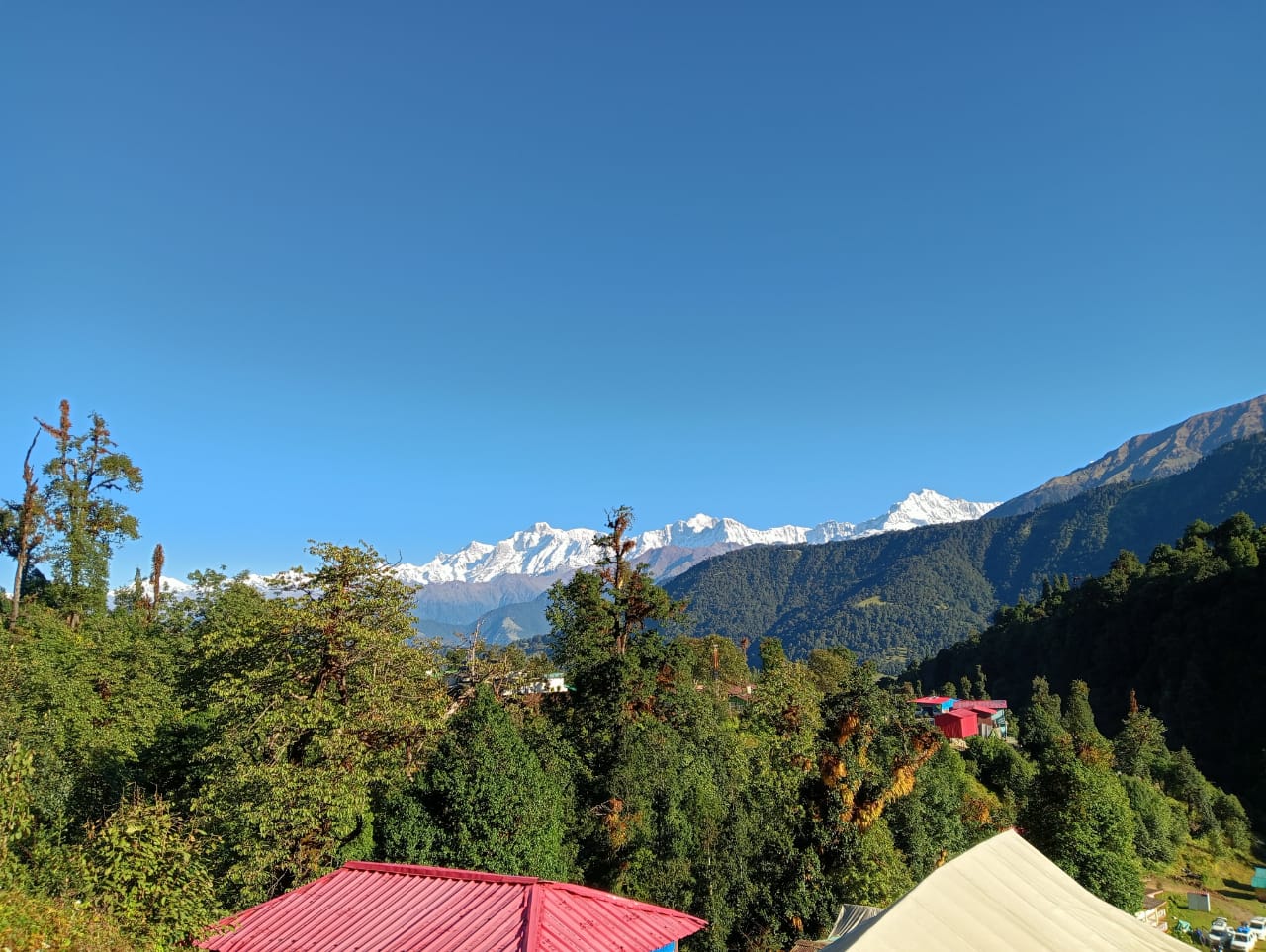
Signs and Symptoms of Altitude Sickness
Recognizing the early signs of altitude sickness is crucial for effective acclimatization. These symptoms typically begin to appear when ascending too quickly to altitudes above 2,500 meters. Common indicators include:
- Mild Symptoms : Headaches, fatigue, loss of appetite, nausea, difficulty sleeping, and mild dizziness.
- Moderate Symptoms : Persistent headaches unrelieved by medication, vomiting, confusion, and extreme lethargy.
- Severe Symptoms : Shortness of breath even at rest, inability to walk straight, chest tightness, coughing up frothy sputum (signs of HAPE), or altered mental states (signs of HACE).
If any of these symptoms arise, it’s essential to stop ascending immediately and give your body time to adjust. In severe cases, descending to a lower altitude may be necessary. Educating yourself about these warning signs before your trek empowers you to respond promptly and prevent complications.
Strategies for Effective Acclimatization
Proper acclimatization requires careful planning and adherence to proven strategies. Here are some key approaches to ensure a smooth adjustment to higher altitudes:
1. Climb High, Sleep Low
This principle is one of the most effective methods for acclimatization. It involves climbing to higher elevations during the day but returning to a lower altitude to sleep. For example, if you’re trekking to Tungnath (3,680 meters) en route to Chandrashila, spend a night at Chopta (2,680 meters) before continuing your ascent. This allows your body to gradually adapt to increasing altitudes while recovering in more oxygen-rich environments overnight.
2. Gradual Ascent
A general rule of thumb is to limit daily elevation gain to no more than 300–500 meters once you exceed 3,000 meters. Incorporating rest days into your itinerary gives your body ample time to adjust. On multi-day treks like those leading to Roopkund or Valley of Flowers, schedule buffer days where you remain at the same altitude to consolidate acclimatization.
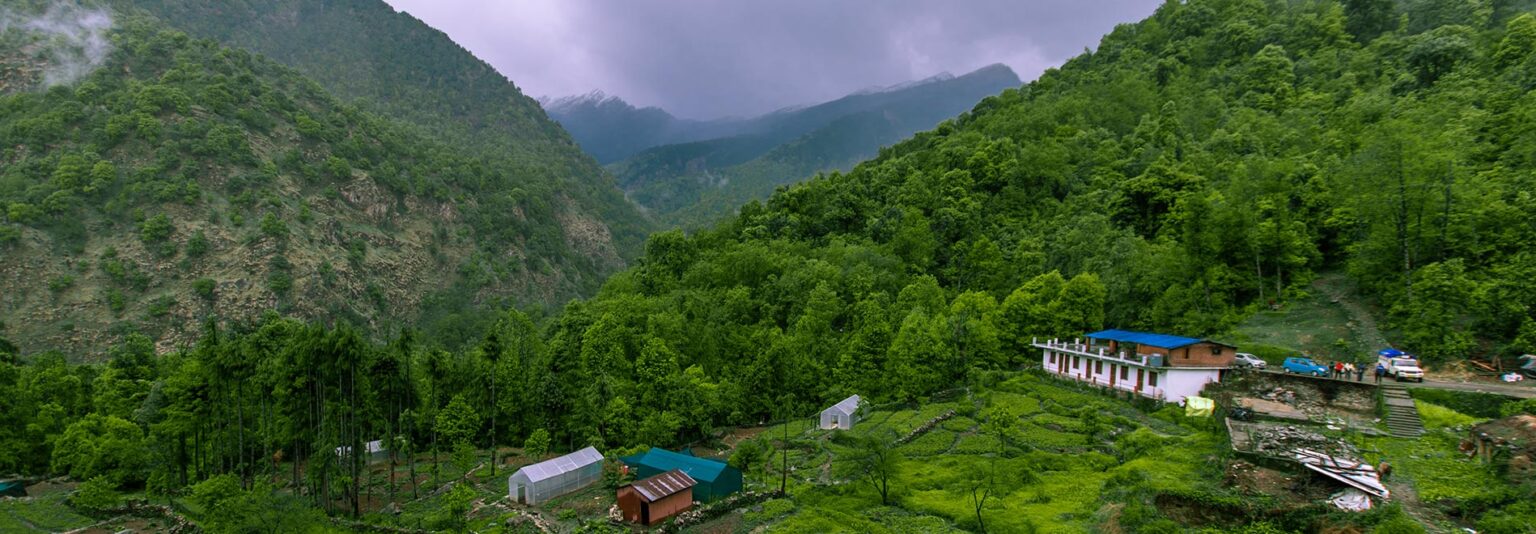
3. Stay Hydrated
Dehydration exacerbates altitude sickness because it reduces blood volume and impairs oxygen transport. Drink plenty of water throughout the day—even if you don’t feel thirsty—and avoid alcohol and caffeine, which can dehydrate your system further. Aim for at least 3–4 liters of water daily, depending on activity level and weather conditions.
4. Eat Nutritious Meals
High-altitude trekking demands significant energy expenditure, so maintaining a balanced diet is vital. Focus on carbohydrate-rich foods like rice, pasta, and potatoes, as carbs require less oxygen for metabolism compared to fats and proteins. Additionally, consuming small, frequent meals rather than large portions helps sustain energy levels without overwhelming your digestive system.
5. Listen to Your Body
Pay close attention to how you’re feeling each day. If you notice persistent headaches or other symptoms despite resting, consider spending an extra day at the current altitude. Pushing through discomfort increases the risk of developing severe altitude sickness. Remember, there’s no shame in slowing down—it’s far better to prioritize safety over speed.
Importance of Rest Days in Acclimatization
Rest days are not just breaks; they are integral components of successful acclimatization. When incorporated strategically into your trekking plan, rest days allow your body to recover and adapt to the stresses of high-altitude environments. For example, many seasoned trekkers recommend spending two nights at key intermediate points, such as Chopta or Deoria Tal, before tackling higher sections like Chandrashila or Tungnath.
During rest days, engage in light activities like short walks or exploring nearby areas instead of remaining completely sedentary. This "active rest" promotes circulation and aids in oxygen absorption without overexerting yourself. Moreover, use this time to hydrate, eat nutritious meals, and mentally prepare for the upcoming stages of your trek.

The Role of Fitness and Preparation
While acclimatization focuses on adapting to altitude, physical fitness lays the foundation for a successful trek. Regular cardiovascular exercise, strength training, and endurance-building workouts prior to your trip enhance your stamina and resilience. Strong leg muscles, core stability, and cardiovascular efficiency help mitigate the physical strain of carrying backpacks and navigating uneven terrains.
Equally important is mental preparation. Trekking at high altitudes tests not only your physical limits but also your patience and determination. Understanding that acclimatization might slow your pace or alter your plans fosters a mindset of flexibility and acceptance. This mental fortitude ensures that you approach challenges calmly and confidently.
Common Misconceptions About Acclimatization
Several myths surround acclimatization, leading to misconceptions that can compromise safety. Addressing these misunderstandings is crucial for responsible trekking:
-
Myth: Only Unfit People Get Altitude Sickness
Fact: Altitude sickness affects individuals regardless of age, gender, or fitness level. Even highly trained athletes can fall victim if they ascend too rapidly. -
Myth: Medication Replaces Acclimatization
Fact: While medications like Diamox (acetazolamide) can aid acclimatization, they are not substitutes for proper ascent protocols. Relying solely on drugs without allowing adequate time for adjustment is risky. -
Myth: Previous Experience Guarantees Immunity
Fact: Each individual’s response to altitude varies, and past success does not guarantee immunity. Factors like hydration, weather, and exertion levels influence susceptibility. -
Myth: Descending Always Solves Problems Immediately
Fact: While descending alleviates symptoms, recovery times vary. Some effects of altitude sickness may persist even after reaching lower elevations.
By dispelling these myths, trekkers can adopt evidence-based practices that prioritize their well-being.

Benefits of Prioritizing Acclimatization
Investing time in acclimatization yields numerous benefits beyond preventing altitude sickness. First and foremost, it enhances your ability to enjoy the trek fully. Instead of battling headaches or exhaustion, you’ll have the energy to marvel at sweeping landscapes, interact with fellow trekkers, and immerse yourself in local culture.
Secondly, acclimatization builds confidence. Knowing that your body has adapted successfully boosts morale and encourages you to tackle future high-altitude adventures. Lastly, it fosters camaraderie among group members, as shared experiences of gradual ascents and rest days create lasting bonds.
People Also Ask
Why is Chopta famous?
Uttarakhand's Chopta is a lovely tiny hill station. The evergreen trees and meadows give this location a dreamlike feel. Chopta is surrounded by the powerful Himalayas, making it a famous hiking location. It's the starting point for trips to Tungnath, Chandrashila, and other interesting places.
How do I go from Delhi to Chopta?
There is no direct connection from New Delhi to Chopta. However, you can take the bus to Samas Pur Jagir, take the bus to Rishikesh, then take the taxi to Chopta. Alternatively, you can take the train to Kotdwara then take the taxi to Chopta.
Which is better, Auli or Chopta?
Auli and Chopta are both beautiful destinations in Uttarakhand, India with panoramic views of the Himalayas. Auli is better for skiing and other adventure activities, while Chopta is better for trekking and spiritual relaxation.
Is snow available in Chopta?
Yes, snow is available in Chopta, Uttarakhand during the winter months. The region is covered in snow from November to March.
Which city is closest to Chopta?
Chopta can be reached from Rishikesh via Rudraprayag, Kund, and Ukhimath or via Rudraprayag, Karnprayag, Chamoli, Gopeshwar, and Mandal. Chopta is simply accessible as it is situated on the road connecting Gopeshwar with Guptkashi.
Can we go Chopta by car?
Yes, you can drive to Chopta, a small town in Uttarakhand, India. You can also take a taxi or hire a car rental service.
How much is a taxi from Rishikesh to Chopta?
For a one-way trip, the Rishikesh to Chopta taxi fare starts from INR 6585.